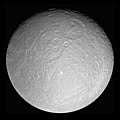File:PIA07763 Rhea full globe5.jpg
Appearance

Size of this preview: 600 × 600 pixels. Other resolutions: 240 × 240 pixels | 480 × 480 pixels | 768 × 768 pixels | 1,024 × 1,024 pixels | 2,048 × 2,048 pixels | 4,920 × 4,920 pixels.
Original file (4,920 × 4,920 pixels, file size: 2.67 MB, MIME type: image/jpeg)
| This is a featured picture, which means that members of the community have identified it as one of the finest images on the English Wikipedia, adding significantly to its accompanying article. If you have a different image of similar quality, be sure to upload it using the proper free license tag, add it to a relevant article, and nominate it. |
| This image was selected as picture of the day on the English Wikipedia for June 28, 2009. |
File history
Click on a date/time to view the file as it appeared at that time.
| Date/Time | Thumbnail | Dimensions | User | Comment | |
|---|---|---|---|---|---|
| current | 07:15, 27 August 2018 |  | 4,920 × 4,920 (2.67 MB) | PlanetUser | Reverted to version as of 08:13, 13 March 2015 (UTC) |
| 10:09, 15 August 2018 |  | 4,920 × 4,920 (2.66 MB) | The NMI User | Reverted to version as of 23:49, 14 August 2018 (UTC) | |
| 23:59, 14 August 2018 |  | 4,920 × 4,920 (2.64 MB) | The NMI User | rv, fixed | |
| 23:49, 14 August 2018 |  | 4,920 × 4,920 (2.66 MB) | The NMI User | Try making black | |
| 23:44, 14 August 2018 |  | 4,920 × 4,920 (2.65 MB) | The NMI User | Fixed | |
| 08:09, 13 August 2018 |  | 4,920 × 4,920 (3.67 MB) | The NMI User | Removing black borders | |
| 08:01, 13 August 2018 |  | 4,920 × 4,920 (2.67 MB) | The NMI User | Reverted to version as of 08:13, 13 March 2015 (UTC) | |
| 07:56, 13 August 2018 |  | 4,920 × 4,920 (5.67 MB) | The NMI User | Black background | |
| 08:13, 13 March 2015 |  | 4,920 × 4,920 (2.67 MB) | MoreTomorrow | making square (to match other planet/moon images) | |
| 06:43, 30 October 2008 |  | 4,920 × 4,820 (2.68 MB) | WolfmanSF | This is the same full-resolution NASA image, with black panels added to the margins and some Photoshop processing to enhance contrast. |
File usage
The following 39 pages use this file:
- Cassini–Huygens
- Discovery and exploration of the Solar System
- Inktomi (crater)
- List of former planets
- List of geological features on Rhea
- List of gravitationally rounded objects of the Solar System
- List of largest craters in the Solar System
- List of natural satellites
- Naming of moons
- Pioneer 11
- Planetary-mass moon
- Rhea (moon)
- Rings of Rhea
- Timeline of discovery of Solar System planets and their moons
- Tirawa (crater)
- Talk:Solar System/Archive 7
- User:ArkHyena/Drafts/Draftspace2
- User:Dabomb87/Sandbox
- User:Fotaun
- User:Jcpag2012/Planetary-mass Objects
- User:JohnAM bva/sandbox
- User:PlanetUser
- User:Spc10K/Intplnt
- User:Tomruen/Dwarf planets
- Wikipedia:Featured picture candidates/November-2008
- Wikipedia:Featured picture candidates/Rhea
- Wikipedia:Featured pictures/Space/Looking out
- Wikipedia:Featured pictures thumbs/13
- Wikipedia:Picture of the day/June 2009
- Wikipedia:Userboxes/Location/Extraterrestrial
- Wikipedia:WikiProject Astronomy/Recognized astronomy content
- Wikipedia:WikiProject Astronomy/Recognized content
- Wikipedia:Wikipedia Signpost/2008-11-08/Features and admins
- Wikipedia:Wikipedia Signpost/2008-11-08/SPV
- Wikipedia:Wikipedia Signpost/Single/2008-11-08
- Template:POTD/2009-06-28
- Template:Rhea (moon)
- Template:User Rhea
- Portal:Solar System/Selected picture
Global file usage
The following other wikis use this file:
- Usage on af.wikipedia.org
- Usage on an.wikipedia.org
- Usage on ar.wikipedia.org
- ريا
- ريا (قمر)
- جيوفاني دومينيكو كاسيني
- قالب:المجموعة الشمسية
- قائمة أجرام المجموعة الشمسية مرتبة حسب الحجم
- قائمة الأجرام المستديرة بالجاذبية في المجموعة الشمسية
- قائمة الأقمار الطبيعية
- خط زمني لاكتشاف كواكب المجموعة الشمسية وأقمارها
- اكتشاف واستكشاف النظام الشمسي
- قائمة أنواع الكواكب
- مهمة نظام تيتان زحل
- قائمة أكبر الفوهات في المجموعة الشمسية
- 1981 ميداس
- حلقات ريا
- قالب:ريا (قمر)
- Usage on ary.wikipedia.org
- Usage on arz.wikipedia.org
- Usage on ast.wikipedia.org
- Usage on as.wikipedia.org
- Usage on azb.wikipedia.org
- Usage on be.wikipedia.org
- Usage on bh.wikipedia.org
- Usage on ca.wikipedia.org
- Usage on ckb.wikipedia.org
- Usage on cy.wikipedia.org
- Usage on de.wikipedia.org
- Usage on el.wikipedia.org
- Usage on en.wikiversity.org
- Usage on eo.wikipedia.org
- Usage on es.wikipedia.org
View more global usage of this file.




